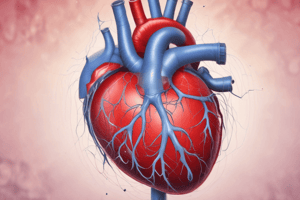Podcast
Questions and Answers
What is heart failure primarily characterized by?
What is heart failure primarily characterized by?
- Increased cardiac output and decreased filling pressures
- Elevation of oxygen supply despite low cardiac output
- Abnormalities of heart structure and/or function (correct)
- Complete recovery of heart muscle after damage
Which statement correctly describes reduced ejection fraction (HFrEF)?
Which statement correctly describes reduced ejection fraction (HFrEF)?
- EF shows normal ventricular size with diastolic dysfunction
- EF is maintained at 50% or higher
- EF is less than 40%, indicative of systolic heart failure (correct)
- EF levels are between 41-49%
What kind of heart failure is characterized by preserved ejection fraction?
What kind of heart failure is characterized by preserved ejection fraction?
- Heart failure with preserved ejection fraction (HFpEF) (correct)
- Systolic heart failure with no preserved function
- Diastolic heart failure with EF < 40%
- Low-output heart failure with normal function
Which of the following is a common consequence of left-sided heart failure?
Which of the following is a common consequence of left-sided heart failure?
Which factors significantly impact the prognosis of heart failure after diagnosis?
Which factors significantly impact the prognosis of heart failure after diagnosis?
What denotes acute heart failure?
What denotes acute heart failure?
What characterizes high-output heart failure?
What characterizes high-output heart failure?
How is mildly reduced ejection fraction (HFmrEF) defined?
How is mildly reduced ejection fraction (HFmrEF) defined?
In the context of time course, what does chronic heart failure imply?
In the context of time course, what does chronic heart failure imply?
What is the prevalence of heart failure in the 80s age group?
What is the prevalence of heart failure in the 80s age group?
Flashcards
What is heart failure (HF)?
What is heart failure (HF)?
Heart failure (HF) is a condition characterized by symptoms and signs resulting from abnormalities in the heart's structure or function, leading to reduced cardiac output or increased filling pressures during rest or exertion. It's a complex syndrome caused by various underlying issues and requires treatment focused on the root cause.
How prevalent is heart failure?
How prevalent is heart failure?
The prevalence of heart failure increases with age. About 1% of individuals in their 50s, 4% in their 60s, and a staggering 25% in their 80s are affected. The ratio of men to women with heart failure is approximately 1.1:1.
What is ejection fraction (EF)?
What is ejection fraction (EF)?
Ejection fraction (EF) is the percentage of blood pumped out of the left ventricle with each heartbeat. Normal EF is ≥ 50%. Reduced EF (< 40%) indicates problems with the heart's ability to contract (systolic heart failure). Preserved EF (≥ 50%) suggests a problem with the heart's ability to relax and fill with blood (diastolic heart failure). EF between 41% and 49% is considered mildly reduced.
What is low-output failure vs high-output failure?
What is low-output failure vs high-output failure?
Signup and view all the flashcards
What is left-sided vs. right-sided heart failure?
What is left-sided vs. right-sided heart failure?
Signup and view all the flashcards
Explain acute vs. chronic heart failure.
Explain acute vs. chronic heart failure.
Signup and view all the flashcards
In what ways can heart failure affect the heart?
In what ways can heart failure affect the heart?
Signup and view all the flashcards
What are some causes of heart failure?
What are some causes of heart failure?
Signup and view all the flashcards
What are some common symptoms of heart failure?
What are some common symptoms of heart failure?
Signup and view all the flashcards
What is the prognosis for heart failure?
What is the prognosis for heart failure?
Signup and view all the flashcards




